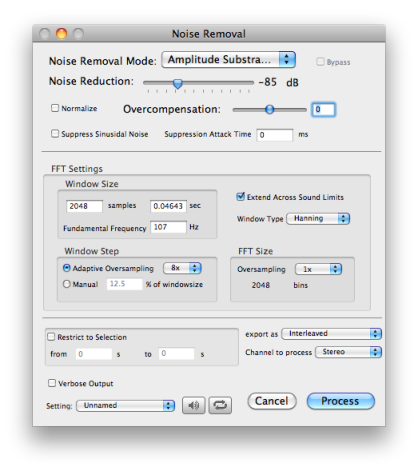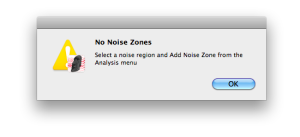Processing Noise Removal
Once a noise zone is defined, the data of the analysis can be applied in the noise removal processing. The spectral component whose amplitude is inferior to a given threshold will be removed.
Dialogue Window
Select Processing/Noise Removal. The following dialogue window will open.

This window is devided into three zones, whose parameters determine the quality of the noise removal, and its application range :
noise removal mode, rate and components to be processed – upper part of the window
FFT settings – central part of the window :
selection of an area or channel, export format – lower part of the window
Parameters
These parameters are thoroughly detailed in the corresponding section of this documentation.
The FFT parameters applied for the definition of the noise zones in the realtime processing settings are automatically upgraded during the noise removal.

Amplitude Substraction : the noise level to be removed is higher, as the noise print is estimated in terms of amplitude.
Energy Substraction : the noise level to be removed is lower, as the noise print is estimated in terms of energy
Noise Reduction : reduction level in dB
Normalization : the resulting file will be normalized so that the maximum amplitude value doesn't exceed the full scale output of the sound format. Normalization is not valid with the preview.
|
The level of some components may vary from the detected level in the noise zone.
The reduction level is never superior to the specified reduction level. |
 | The noise removal can be applied to a selected region of the file, even if the noise zone(s) are located outside this region.
|
For detailed information about other common options of the dialogue window, such as export format, and channels processing, see the corresponding page of the Signal Processing section.
- Introduction
- About this Document
- Introduction
- Installation
- Going Through an AS Session
- The AudioSculpt Environment
- Signal Representation
- Signal Analysis
- Modeling Sounds with Sinusoids
- Signal Manipulation
- Normalization, Noise, Gain
- Noise Removal
- Noise Zone
- Manipulating Noise Zones
- Noise Zones Export and Import
- Noise Zones Interpolation
- Processing Noise Removal
- Gain Envelope
- Pitch and Spectral Envelope Modifications
- BPFs Manipulations – General Guidelines
- Spectral Clipping
- Dynamic Filtering
- Surface Filters
- Spectrum Manipulation and Treatments
- Processing Parameters
- Managing Treatments
- Processing Sequencer
- Advanced Use
- Errors and Problems
- Basic Analysis/Synthesis Notions

